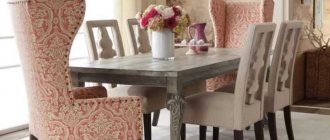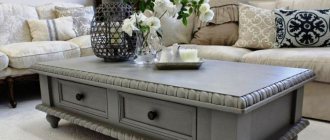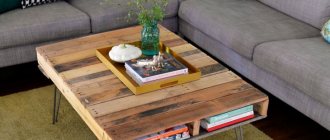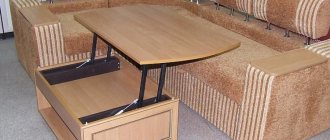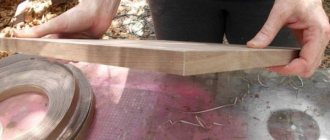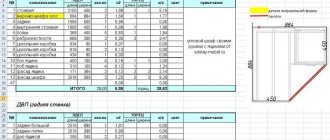Since ancient times, it has been customary to store bread in wooden boxes, which people began to call bread bins. Thanks to this device, the baked goods remained fresh and did not go stale for a long time. Modern bread bins perform the same functions as their predecessors, but now they are more functional and easy to use.
Now you can buy this device at any hardware store. But a do-it-yourself wooden bread box will become a real decoration for the interior of any kitchen and will retain the warmth of the master’s hands. Where to start and what material will you need?
You need to prepare first before starting the manufacturing process. Stock up on all the necessary tools and materials, prepare drawings of the future product in accordance with the dimensions, as well as the method of functioning of the door. You can even make an approximate model if such work is being carried out for the first time. The design is thought out last.
First you need to choose the material from which the case will be made. A homemade bread box can be made from:
- Plywood
- Trees
- Bamboo
- Birch bark
Any of these materials perfectly allows air to pass through and regulates moisture inside the bread box - they are often combined in one product. Thanks to these properties of wood, bread retains its taste and smell for a long time. Small screws and wood glue are used for fastenings and connections. Depending on how the door will open, you may need small hinges and a handle. Bread bins come in several types depending on the door design methods:
- Simple
- carved
- Curtain blinds
A standard carpenter's kit will do the job. The surface finish of a product can be different - it is determined by the design, and, accordingly, the finishing materials for the coating.
In our village, in my grandmother’s kitchen, as long as I can remember, there was always a bread box made of wood with my own hands, which my grandfather made. It kept the bread fresh for a long time. After many years of life, it was in a deplorable state, and Elya decided to update it, decorating it using decoupage technique. Here is her photo.
And so, on one of her visits, Elechka suddenly wanted a similar thing to appear in our home, which she would decorate in her favorite Provence style. You can, of course, buy it, but why, when there is a handy man nearby, she reasoned. And she puzzled me with this question: do it, you’re a jack of all trades with us. Well, how can you refuse your beloved wife? So I got down to business.
At first I wanted to make it out of wood, but we sell mostly coniferous wood, which is not recommended for use in this product. Pine and fir have too strong a smell, which will overwhelm the aroma of baking. In the end I settled on birch plywood.
In today’s article I will describe the manufacturing process, and I will attach drawings of a plywood bread bin at the end of the article. They were made in the Compass program, but you will understand everything even without drawings from the photo, and can repeat it if you wish.
Tasks before production
First, I’ll tell you what tasks I wanted to implement when creating this bread box.
- Simplicity of design and ease of execution
- Manufacturing without the use of connecting elements (in the form of staples, door handles, nails, etc.)
- The bread box door could be used as a cutting board.
- The roof of the bread bin had a flat surface so that it could be used as a shelf.
Taking a break from the Internet, on one of the forums dedicated to carpentry, I came across the presented diagram and I liked it. Unfortunately, the original source was lost, and attempts to find it again were unsuccessful, so don’t blame me, I don’t claim primacy. It differed only in that it was without curves and decorative elements. Well, something like this.
Breadbox making process
For manufacturing we need plywood, in this case I used 8 mm thick plywood and 2/4 grade sanded. I leave the choice of material to your discretion; wood can also be used successfully.
Having made a drawing of the future side walls on a sheet of plywood, we proceed to cutting. For clarity, I present a drawing on plywood with dimensions.
I cut it with a hand-held electric jigsaw, but this is not a panacea. If you have a table saw or router that can make a clean cut, that's even better. Unfortunately, I don’t have such machines, so I did it with what I have.
I draw your attention to small tricks:
To ensure that the edges are burr-free, apply tape to the cut area. Ideally, it should be durable metallized tape, however, ordinary transparent tape from Leroy Merlin did the job perfectly.
If, when cutting with a jigsaw, you get a crooked cut, then you can go over the edges with a hand router using a ruler; I used to do this. With practice, it is possible to obtain a straight cut without deviation. The main thing is that the ultimately obtained parts have dimensions in accordance with the drawing
Having cut out two side walls according to the drawing from a sheet of plywood, I made grooves using a router. Because plywood thickness 8 mm, groove cutter d=8mm was used. If you will be making from plywood of a different thickness, use the appropriate router bit.
Please note that it is necessary to mill the grooves when both walls are still connected. This way we get grooves on both parts at the same level, and during assembly this will allow us to assemble the product without distortions.
The rear wall connection is made with a partial groove along the edge of the side wall. Thus, the aesthetic integrity is maintained when viewed from the side of the bread bin (when it stands against the wall in the kitchen) and the strength of the connection when gluing.
Because All our grooves are made with recesses to the same depth, then we make the roof, bottom, back wall and lid of the bread box the same width. In our case, 30 cm.
If you cut everything out carefully with geometrically even cuts, you should not have any difficulties with assembly. The only caveat is that to ensure easy movement of the lid in the grooves, you can go in two ways: 1) Make the width of the lid 1 mm less than the roof and bottom of the bread bin. 2) Enlarge the guide groove slightly using sandpaper or using a cutter with a slightly larger diameter. I went with the first of the proposed options.
To personalize the shapes of the sides and back wall, I made cutouts using my jigsaw. Here you can make any cut you like, it all depends on your wishes. To maintain symmetry, I first made a drawing in the Compass program and, after printing it, pasted it onto the sides and then sawed it out.
LiveInternetLiveInternet
A bread box made of wood is an environmentally friendly item that allows you to keep bread soft for a long period of time. In addition, it is a beautiful decorative item that complements the chosen kitchen design. If you are a creative person and love to fill your home with original, handmade items, you should definitely make your own bread bin!
Making a bread box from wood yourself
To make a wood product, choose varieties such as linden, birch or ash. Conifers have a pungent odor that will be transferred to the bread. For manufacturing, you will need to complete the following stages of work:
Cut out all parts from wood in accordance with the drawing. A prerequisite is the tight connection of all elements with each other.
Product dimensions may vary. The parts can be fastened together with screws, furniture nails, or use wood glue.
If you have experience in carpentry, then you can use a tenon to create a fastener.
To improve the joining, the joints are coated with wood glue.
Don't forget to sand the cut areas with sandpaper.
The door is made separately.
Most often this is a curtain that is made of small slats.
To ensure the movement of the curtain, a groove is made on the body along which the door moves.
The structure is coated with a special varnish or stain.
On a note! You can make a curtain door that opens outward. It is also made from narrow planks, instead of which a bamboo mat is sometimes used.
Natural material ensures environmental friendliness and is combined with different interior design styles.
Bamboo bread bins are another simple option.
This material can be used as a decoration for a wooden product or made from it into small bread bins. The main advantage will be the speed of completion of the work. It only takes you a few hours to create a bread box!
To carry out the work you will need: Bamboo napkins. Thick fabric. Durable cardboard. Scissors. Self-adhesive. Pencil. Door fittings.
To get the job done quickly, you should follow some recommendations:
— dimensions are limited by the size of the napkins; the body of the structure is made of cardboard;
- on one side, the side walls are made rounded - this allows the door to fit tightly and move without problems; - all parts are connected using glue;
— the outside and inside of the structure is covered with self-adhesive, which will provide the product with additional strength;
- at the final stage, finishing with bamboo occurs. To do this, cut the napkin in two: the first part is suitable for the door, the second for the bottom.
Decorating options Tip!
You can make a version of the product with several compartments. This production makes it possible to conveniently use and sort flour and bakery products. The separator is made of slats or a thin board.
Hand-made bread bins are distinguished by individuality and original design, and all this thanks to exclusive decorative methods. Several centuries ago, rich decorative elements were applied to bread storage products using veneer, carving, engraving and painting. In aristocratic houses one could find boxes with monograms. In poor houses, items made of birch bark were used. Peasants used wicker options for storing bread.
To create a beautiful and individual decoration, you can choose different methods:
— Wood carving allows you to create relief compositions from ornaments, patterns or images. You can choose natural motifs and create them using milling.
— Decoupage is a technique of pasting napkins with bright, beautiful motifs. This design option is well suited for wooden products. The surface needs to be made smooth, then the napkin will repeat the silhouette of the structure without flaws. Newspaper clippings or postcards also work.
On a note! To get inspired by ideas for creating a bread box, you can watch a variety of photos or videos with design options. An original design made by yourself will look attractive in different interior styles and will last for a long time!
Gluing and assembling the bread box
Well, the final stage is assembly by gluing. PVA D3 wood glue was used for gluing.
And here is an example of a bread box after decoration using the decoupage technique.
And finally, as promised, the drawings made in the Compass program can be downloaded from the link.
Let this review of how to make a bread box help you create your own products, and let the resulting bread box delight you with its functionality and decorate your kitchen.
All photos from the article
Almost anyone can make a bread box out of plywood with their own hands, since this does not require expensive equipment. You can get by with a simple tool and a few tips, which we will describe in our article. The most important thing is to be careful and use high-quality material, since the structure will be used for storing food.
Birch bark bread box
Many craftsmen are interested in: how to make a bread box from birch bark? This material is very soft and pliable for weaving. It is difficult to buy this material, but you can make it yourself by cutting off the top layer of birch bark.
Since the body of the product is formed thanks to weaving, the bread box in appearance resembles a box with a lid. Over time, the birch bark material hardens.
Weaving methods:
- Rug
- Angular
In this case, you need to monitor the formation of the edges of the panels - they should be smooth and tightly woven. To do this, they use several basic tricks, adding stripes for rounding.
The fabric for the lid and bottom is woven of the same size, and the same applies to the side sections. The connection is a strip of birch bark, which is woven into the gaps of the panels. A DIY birch bark bread box will make your kitchen interior more unique and authentic.
What you need for work
If you decide to make a bread box, then first of all you will need to have the following materials and accessories on hand:
| Plywood | This is the main material, the quality of which is very demanding; it is best to choose the 1/1 grade, in which both sides are attractive and reliable. You also need to choose the ideal sanded sheets, then you will have to process the surfaces much less, which will significantly simplify and speed up the work process, their price is higher, but the difference is not so great |
| Accessories | Here you can, which are used when the doors are made in the form of latches, or curtains, if the door will be attached to them. Handles are also used, which should be not only comfortable, but also beautiful. As for fasteners, it is best to use 3 mm thick self-tapping screws, and additionally strengthen all connections with wood glue |
| Tool | Either a hand or power tool is used to cut the material. Do not forget about the need to grind the ends; for this, ordinary sandpaper with different grain sizes is used |
| Protective compounds | The wooden surface must be protected from moisture and contamination by applying a protective coating. Since we will be making a bread box, it is necessary to use either special oils or food varnishes to eliminate the negative impact on human health |
Important! To make a high-quality product, you need to take very careful measurements and mark out all the elements. In this work you cannot do without a tape measure, a ruler, a square and a carpenter's pencil.
Process description
We will tell you how to properly prepare the material, how to choose it, and what nuances you should pay close attention to. Every detail is important here, so you should carefully follow all recommendations.
Preparatory stage
This stage includes a number of important actions:
- First you need to choose a high-quality manufacturing material; it is better to use plywood with a thickness of about 10 mm, then the bread box will be durable and can withstand even significant loads. We recommend using options with a top layer of birch veneer, since this wood is harder and does not emit resins, unlike coniferous species;
- You also need to make drawings of the bread box with your own hands from plywood, perfect accuracy is not needed here, the most important thing is to determine all the dimensions so that you can clearly navigate the work process and avoid mistakes. You can use ready-made options from the Internet or specialized literature; finding them will not be difficult, and we will tell you about one interesting solution;
- Based on the sketch, the dimensions of all elements are determined, and then it is necessary to draw a sheet of plywood. Arrange each element wisely to use material as economically and efficiently as possible.
Cutting and assembly
The main work begins after marking, there is nothing complicated about it, however, the instructions presented in this chapter will help you understand the process even better:
- First of all, you need to cut all the elements, for this you use either a jigsaw or a hand saw with a fine tooth. The material is very easily damaged when sawing, so along all lines it is necessary to apply a mixture of wood glue and water in a ratio of 1:2 and wait until the composition dries;
Important! When working with a hand tool, do not press too hard, this will allow you to achieve maximum results.
- After cutting, you need to carefully process all the ends; for this, ordinary sandpaper is enough; the surfaces are leveled and rounded to make the elements more attractive;
- Grooves are cut into the sides for doors, which simultaneously serve as boards for cutting bread. In the middle there is a partition on which there is a block with grooves. You can do it simpler: do not make a partition, but attach a solid door to the curtains; the decision is up to you;
- Next, the elements are fastened together; it is important to drill small-diameter holes before screwing in the screws to avoid cracks in the material. It is better to choose thinner fasteners so that they are unnoticeable on the finished product; the caps are recessed and then sealed with putty to match the color of the surface;
- Then you need to attach the doors if they will be installed on curtains. Also, don’t forget about the handles; with their help, using the bread box will be much more convenient. Lastly, a protective composition is applied to the surface.
Learn to make bread bins from wood, birch bark and the most unexpected materials, such as plastic bottles, cardboard, paper.
DIY bread box from a plastic bottle: master class
The master class video itself:
To make this bread tray you will need:
- five-liter canister;
- scissors;
- five-ruble coin;
- napkins;
- PVA glue;
- water;
- halves of dry peas;
- acrylic paint in brown, lilac and gold;
- acrylic lacquer;
- tassels;
- marker.
Cut off the bottom and neck of a 5-liter plastic canister.
Lay it on its side, mark 8 cm at the bottom, cut horizontally on one side and the other to divide the workpiece into two halves. Don't throw away the bottom of the bottle; cut it in half. You will need two semicircular rings from it, which need to be glued on both sides to the main part. Positioning the tape across, attach them to the 1st and 2nd half of the bottle, which will soon turn into a bread box. Cut newspapers into strips, dilute PVA glue with water approximately twice. Dipping strips of newspaper here, cover the plastic blank with them on the outside and inside in two layers. Now generously coat this paper surface on both sides with PVA glue using a brush. Take the top of the bottle, cut off the neck, it is not needed. Cover the workpiece with newspapers as well. Wait until these parts are completely dry. Then glue the small round one onto the large one using a hot gun. Draw wavy lines along the edge of the bread box and the rounded leg part that will become the stand. It is convenient to draw the openwork edge using a coin, placing it next to the previous outline, and also outline it with a marker.
Cut along these markings with scissors. Dilute the PVA glue with water again in a ratio of one to one, coat the workpiece with this mixture, and glue thin napkins here in one or two layers.
Take thick napkins with a pattern, separate this upper colored part, you will only need the lower white part. Roll each into a thin tube on the table, moistening it with water. You will need to make an edging with these elements and glue them along the wavy edge of the bread box.
Now glue the halves of dry peas along the edges, placing them with the convex side out. This is how the bread box is further transformed. You will need to draw patterns on it with your own hands, then glue here various curls from napkins previously rolled into a tube. To do this, apply glue using a thin brush, then attach the paper elements here. When they are well dry, paint the bread box with black acrylic paint. Then apply lilac paint to the coils and other elements of the decoration, and then go over it with gold paint. All that remains is to coat the product with acrylic varnish and wait for it to dry completely. Now you can put a napkin inside, lay out the bread and serve it to the table.
Wooden bread bin design
In addition to making a base for storing bread, it is important to think about the decor of the product. Homemade bread boxes with smooth, simple details leave room for creativity. Over the centuries, traditions have developed to decorate kitchen boxes with wooden overlays, painting, engraving motifs, etc.
Table 1. Decoration methods.
NameThe essence of the technique
Carved elements | A good way to decorate a bread box and make it attractive is to add relief to it. The image can be anything - from individual parts of a pattern and ornament to large compositions. Nature motifs, fairy-tale characters and human figures look attractive on wood. Pictures are cut out on wooden parts using a hand router or an automatic router. |
Decoupage technique | Popular in various fields of creativity, napkin technology allows you to decorate accessories and kitchen interior items with picturesque illustrations. Perfect for wood and perfectly flat surfaces, which is typical for many models of bread bins. In this case, a piece of a napkin or a picture from a book or magazine will lie perfectly flat, repeating the silhouette of the part and merging with the base. For decoupage, use any images, including newspaper clippings and postcards. |
painting | This method is suitable for those who are good at drawing. Brushes, wood paints and imagination are the ingredients for a well-structured composition and skillfully selected bread box decor. A beautifully painted surface can contain any elements that fit into the style of the space: flowers, birds, landscapes, portraits of people in the interior, etc. |
Craquelure | Craquelure can act as an independent decorative element or as an additional one. Its essence lies in the artificial aging of the surface. For this you need brushes, a special composition, and protective gloves. The antique-decorated surface gives a stylish look to many household items within the framework of the corresponding interior style. |
Decoupage of a wooden bread box
In this material, we will consider one of the techniques for creating a unique handmade bread box - applying images to a wooden surface using the decoupage technique.
For high-quality execution and decoration of the product, the craftsman will need the following materials.
- elements with a pattern that can be glued (on a thin base - including part of a napkin, the top of a thick card sheet, etc.);
- sandpaper;
- scissors;
- acrylic primer;
- acrylic paint;
- varnish for woodworking;
- PVA glue;
- brush.
The scheme for decorating a bread box using the decoupage technique is presented in the form of a series of steps.
Step 1. The wooden surface of the bread box is rubbed with a layer of sandpaper
At this stage, a workpiece with a smooth surface is obtained
Step 2. Prime the surface and let it dry.
Priming the wooden parts of the bread box
Step 3. Apply a layer of paint with a brush and wait for the first layer to dry completely.
The number of paint layers can be any - at the discretion of the master
Step 4. Decorative elements are smeared with PVA glue or special glue for decoupage and attached to the wooden parts of the bread box. They are carefully leveled so that no wrinkles appear on the surface of the wood, and they are also allowed to completely dry the wood along with the glue.
Decoupage involves gluing parts in a special way.
Step 5. At the end of the work, a finishing coating is applied. This can be a standard layer of varnish or craquelure to create an antique effect on a handmade item.
If necessary, work with the first and subsequent layers of varnish is carried out the next day. It is not necessary to complete the work at once if you can wait. If you have time, you should pause to make the product look even more impressive. For example, when using craquelure between the first and final coats, you can use oil umber to fill the cracks that have formed and make them stand out visually.
The product is varnished
Step 6. Completing work using the decoupage technique always involves covering the product with several layers of acrylic varnish - two or three are enough to create a glossy or matte effect and visually complete the composition. Aged areas can also be tinted with bitumen, decorated with vintage tape, as well as wooden overlays with a thematic picture applied using the same technique.
The effect of antiquity is emphasized by varnishing works
Decoupage accompanies not only the base of the bread box and its lid, but also decorates the sides and individual elements.
Video - Decoupage of a wooden bread box
DIY bread box made of fabric and cardboard
Surprisingly, these materials will also help you make a bread basket. It will look good in such a container; this device will help you set the table in an unusual way.
To sew it, take:
- two square pieces of cotton fabric with sides 28 cm;
- square sheet of cardboard with sides 27 cm;
- ruler;
- scotch;
- pins;
- ironing board;
- iron;
- scissors;
- braid.
Place both fabrics with right sides facing each other, stitch, leaving one side unstitched.
This is necessary in order to turn the resulting bag right side out. Insert a sheet of cardboard here and stitch the unsewn side. To ensure that the edges of the bread box are decorated equally, make the same stitch along the entire edge of the rectangle.
Stepping back 7 cm from the edges, draw a square inside with chalk, which also needs to be stitched. Connect the corners, pin them together with a pin, and machine stitch here.
If you want to sew a round bread box from fabric and cardboard, then with your own hands you need to draw a circle on thick paper, this will be the diameter of your product along with the sides. It is necessary to cut out 2 canvases, place a circle of cardboard between them, sew up the edges using braid. You will sew it on the edges perpendicular to this surface. A total of 12 tapes are needed, two for each fragment. Then you tie them up and make a bread box with sides. Instead of fabric, you can use a blank that you knit yourself. This is very easy to do. The result should be a square like this, but without corners. Two identical parts are required. Place it on a piece of cardboard and cut it out using this template. Fold the product so that the two cut out parts are on top and bottom, and the cardboard is inside. But first, the sides of the cardboard need to be bent to give the product its shape.
Sew it at the corners and you will get a bread basket like this.
If you want to close the device so that the bread does not go stale, then adopt the following type of needlework.
From a plastic bottle
A bread box made from a plastic bottle is not intended for storing bread. The chopped product is placed in it immediately before serving.
Tools and materials
In order to create this masterpiece of handicraft art, you need to buy or find at home:
- A five-liter rectangular bottle with smooth walls. Bottles with various concavities and convexities, too ribbed, will not work.
- Acrylic paints. You can choose their color according to your taste, choosing a beautiful combination. Recommended - black, lilac and gold; they will give the product a vintage look.
- Scissors.
- Acrylic lacquer.
- Tassels.
- Newspapers.
- PVA glue.
- Multilayer napkins.
- Glue gun.
- Transparent tape.
- A handful of halved peas.
- Ruler and felt-tip pen.
Description of work
The process of creating such a bread box will require perseverance and accuracy:
- Cutting out the main parts. This stage consists of several actions:
- Cut off the bottom and neck where the ribbed part begins.
- Using a ruler, measure 8 cm in several places on two parallel sides of the bottle, making a mark with a felt-tip pen. All marks are connected into one line, along which they are then cut with scissors.
- The bottom is cut exactly in half and the concave parts are cut out.
- A narrow neck is cut off from the neck so that the workpiece remains in the shape of a cut cone.
- Start of assembly. Two semicircular parts, which were obtained from the bottom of the bottle, are glued with tape on both sides of the “boat” formed from the side part.
- Pasting with newspapers. To do this, they are cut into strips, and the glue is diluted with water in a ratio of one to two, after which the plastic blank is pasted over in two layers. Newspaper covering should be both outside and inside. The same is done with the cone-shaped part.
- Continued assembly. When the newspaper layers have dried well, the boat part and the cone part are fastened together using a glue gun.
- Creating curly edges. Along the upper edge of the boat part and the lower edge of the cone part you need to make semicircular waves. They are cut out with scissors, and to make the semicircular protrusions the same, use a coin or a circle cut out of cardboard as a pattern.
- Decorating the bread box. Occurs in several stages:
- A rope is twisted from thick napkins and glued along the figured edge to create a voluminous edging.
- Halves of peas are glued inside the semicircular protrusions.
- Using a marker, draw the desired patterns on all the parts and stick strands twisted from napkins on top of them.
- Coloring. First, the entire surface of the bread box is covered with black acrylic. On top of it, the strands and peas are painted dark lilac, and after drying, golden paint is applied to the protuberances.
- Varnishing. Finally, the bread box is varnished and, after the varnish has dried, used for its intended purpose.
A bread box made by yourself will delight the owners of the house and surprise their guests, because if you show your imagination, such an item will turn out to be exclusive.
Weaving a bread box from newspapers and paper: master class
This is how beautiful bread boxes made from tubes turn out. To do this, take:
- newspaper and magazines;
- thin stick;
- clothespins;
- tray with sides.
If this is a decorative bread box, you can use newspapers, but for a real one it is better to take thick paper that does not contain dyes.
First you need. Let's start weaving a cover out of them first. Take 6, place them next to each other. Place two more on top of them, securing them with the third. Using the same technology, attach two more tubes, placing them next to the ones you just attached. Take a couple more of these elements and place them next to the ones you just made. Also secure the data using the third tube, placing it in a cross. Continue to weave, but in a circle with a rope of two tubes. See what should happen at this stage. As you can see, this blank needs to be attached with clothespins to a rectangular base. Then, use a tray for this. To give the tube bread baskets an oval shape, then weave only on the elongated sides. After this, weave again in a circle, then braid the sides of a deep tray or other container of a similar shape. In the same way, not only the lid is created, but also the base of the bread box with your own hands with lower sides. Make a handle on the lid so that you can take this item off and on. This is how weaving from newspapers or paper is done. If you have the opportunity to work with wood, then look at another option for making this useful item.
Wooden bread box
Making a wooden bread box with your own hands is quite simple. It is worth considering that the ideal options for this would be linden, ash and birch. Pine and spruce have too strong a smell that will absorb the bread. The manufacturing process itself can be divided into the following stages:
- According to the drawing, all the elements that should fit tightly together are cut out of wood. The sizes can be arbitrary. An example of parameters is shown in the figure.
- The parts can be connected with screws, furniture nails or wood glue. More skilled craftsmen use tenon joints. Spikes form on some parts, and notches form on others.
- The seams at the joints are coated with glue for better connection. In this case, all connections must be carefully processed. This is done using sandpaper.
- At the end the door is made. A modern wooden bread bin is usually equipped with a curtain door, which is made of thin slats.
- In order for the curtain door to move, you need to make a groove inside the body of the product, along which this element will move.
You can make a simpler version of the door. In this case, the curtain will fold outward. It is also made from thin strips. Often the slats are replaced with a bamboo mat, which is stitched with strong thread.
In any case, such bread bins will be quite spacious and functional. Thanks to the material, the product is completely environmentally friendly and will suit any interior style. The surface can be opened with wood varnish, having previously painted it with a pattern. Those who do carpentry can decorate the body with wood carvings.
DIY bread box made of wood
For this type of work you will use:
- planks;
- bamboo mat;
- wood glue;
- small carnations;
- wine cork;
- furniture handle;
- plastic food mat;
- furniture stapler.
The dimensions of the elements of this product are shown in the photograph.
- under the number 1 there are four parts - 2 will go for the bottom, one is for the top, another one is for the back panel;
- under the number 2 there are two sidewalls;
- number 3 is the front panel.
Everything is extremely simple.
You need to cut out these parts and knock them down with small nails. After which the corners at the top are sawed off. Saw the wine cork into 7 pieces and glue them to the bottom surface of the bread box. They will become the legs of this item. Attach a furniture handle to the bottom of the mat, and attach it to the front panel of the bread bin using a furniture stapler. Use a plastic cutting board as a tray; you can saw off the excess. To make the sides, make small cuts in the corners and lift the edges of the pallet up.
This is how you will get a wonderful bread box, made with your own hands from wood and a mat.
Breadbox made of birch bark: master class
Before you make it, read the rules for preparing this material.
- In order not to destroy the tree, birch bark must be harvested in permitted places where trees are subject to felling.
- Collect bark during the sap period, when it is most pliable.
- Birch bark is dried naturally, without the use of fans and radiators.
- After this, various irregularities are cut off so that it becomes as smooth as possible on both sides.
- Boil water, put birch bark here, boil for half an hour.
- The last stage is drying the material, after which you can move on to creativity.
To get such a wonderful birch bark bread box, you need to use a sharp knife to cut it into ribbons, from which we will create a craft.
In common parlance this type of weaving is called a “rug”. You can use two weaving options. For the first one, you need to lay an even number of strips horizontally. Starting from the left edge, weave them through one another. The second strip is also attached vertically, but in a checkerboard pattern with respect to the first. The third tape repeats the amplitude of the first. For the second method, you need to bend the edges of the previous tape onto the subsequent ones.
To secure the edge of the straight weave, when creating this fragment of a birch bark bread box, add wire made of stainless metal.
See how to add additional ribbon during the weaving process. To create a bread box from birch bark, take 24 strips cut from this material. Half of them will be needed for the vertical, half for the horizontal. When you complete the body, you need to decorate the corners between 5 and 6 with tape, using the same method indicated above.
Then you need to make a bread box lid, the height of which is 1.5–2 diagonals from strips. Finish the edge with teeth.
In such a birch bark bread box, bread will remain fresh for a long time and will not become moldy, since this natural material has bactericidal properties.
You already know how to make a bread box from wood. But not everyone has such planks and tools for cutting them. Check out another master class that will solve this problem.
Storing food in birch bark boxes, bread bins and dishes
A bread box made of birch bark, reviews of which are purely positive, has a number of advantages
in front of wooden products. Birch bark, that is, the top layer of birch bark, does not absorb surrounding odors at all and does not interrupt the aroma of baked goods with specific resinous-woody notes, which is characteristic of maple, oak, pine and other tree species.
In Rus', birch bark was respectfully called “white gold” and was used everywhere: in buildings, home decoration, for making dishes and household utensils. Birch bark was used to wrap the crowns of log cabins, as it perfectly protects the wood from rotting
. They not only went mushroom hunting with birch boxes, they also stored cereals, salt, flour, honey, milk, soaked berries, and drank kvass and other cold drinks from birch bark mugs.
Bread in a birch bark bread bin can be stored for 3 to 5 days, while remaining fresh, soft and not moldy. The whole secret lies in the amazing properties of birch bark , a natural, plastic, rot-resistant and amazingly beautiful ornamental material. Birch bark contains silver ions
, preventing the growth of bacteria, and thanks to the peculiar “windows” (these are the same black stripes on the bark of birch trees), birch bark breathes, playing the role of a natural membrane.
DIY bread box made from affordable materials
To make this, take:
- thick cardboard;
- bamboo napkin;
- scissors;
- self-adhesive tape;
- textile;
- lace;
- glue;
- ruler;
- pencil;
- Furniture handle.
Calculate the size of the bread box parts based on the size of the napkin. In this case, the napkin is 30 cm wide, so the width of the bread box will be 28 cm. Based on these dimensions, cut out from cardboard:
- front wall 28 by 3.5 cm;
- bottom measuring 20 by 28 cm;
- two sidewalls measuring 20 by 17 cm;
- the back wall measures 28 by 17 cm.
To ensure that the napkin fits well on the sides, use scissors to round off their sharp corners.
Start assembling the frame of the bread box by gluing its parts. Now you need to cover this blank with self-adhesive film. Choose a color so that it harmonizes with the color of the kitchen. If you like wooden products, then you can also take rattan film. Stick it not only from the inside, but also from the outside. Take a napkin and cut a strip from it that you will use to decorate the front panel of the bread box. Glue this part, decorate the top edge with lace, attaching it in the same way. We continue to work with the large remaining part of the napkin. Sometimes on such things the reverse side is decorated with a piece of fabric; if you don’t have this, then glue the fabric to the back of the napkin.
On the front side, glue the lace on the sides and bottom. Glue part of this napkin to the back wall so that it goes down and covers the front of the bread box. Now you understand why the napkin should be a couple of centimeters wider than the bread box. To make it more convenient to fold back the napkin to remove or put in bread, glue a small wooden handle to the bottom. This is such a wonderful device for storing bread. You will spend a minimum of money on it, and if you decide to buy a bread box in a store, it will cost you much more.
